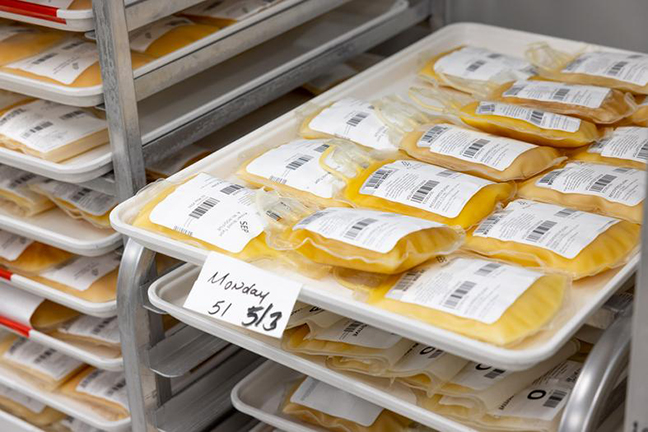Modified Blood Components


Vitalant routinely provides leukocyte-reduced red blood cell (RBC) and platelet components. Leukocyte-reduced products decrease the risk of transfusion-transmitted cytomegalovirus (CMV) infection, the incidence of human leukocyte antigen (HLA) alloimmunization and the frequency of febrile nonhemolytic transfusion reactions (FNHTR). An occasional special unit (e.g., autologous unit imported from another center or a deglycerolized RBC) may not be leukocyte-reduced. If the unit is required to be transfused as leukocyte-reduced then the transfusion facility must use a leukocyte reduction filter.

Patients at risk for developing transfusion-associated, graft-versus-host disease (TA-GVHD) should receive irradiated cellular components. Examples include, but are not limited to the following:
- Congenital immunodeficiency
- Hematopoetic cell transplant candidates and recipients
- Intrauterine transfusions or neonatal exchange transfusions
- Premature infants
- Patients receiving components from blood relatives
- Patients receiving HLA-matched or crossmatched platelets
- Patients receiving granulocytes
- Patients on medications that increase the risk for TA-GVHD (e.g., fludarabine, alemtuzumab, clofarabine, etc.)
Irradiated RBCs have an expiration date of 28 days from irradiation. If the unit has an expiration date less than 28 days prior to irradiation, the shorter date must be used.

Removal of excess donor plasma from cellular components may be indicated for patients who cannot tolerate the full volume and in certain other clinical scenarios. The extra centrifugation step will cause some platelet activation and loss of function. Volume-reduced platelets have a four-hour expiration.

Certain clinical situations, including severe or life-threatening allergies to elements in plasma, may require the use of washed RBCs and platelets. These cellular products are generally resuspended in saline with very little plasma proteins remaining. Washed RBCs expire within either 24 hours if prepared in an open system or two weeks if prepared in a closed system. The washing process leads to red cell loss and a corresponding (albeit, relatively small) reduction in product efficacy. The recovery and function of platelets after washing are impaired and these products outdate in four hours.

RBCs may be frozen for up to 10 years when their antigen makeup is considered ‘rare’ or for other special reasons. When a transfusion service requests antigen-negative blood not found in readily available liquid units, frozen units may be available. Through a process of deglycerolization, the cells are thawed and resuspended in saline. Deglycerolized RBCs have a 24-hour expiration date if prepared in an open system. If prepared in a closed system, deglycerolized RBCs have a two-week expiration.

CMV-seronegative cellular components are provided upon request. Both leukocyte-reduced blood and CMV-seronegative blood have been shown to reduce the risk of transmitting CMV infection through transfusion. However, breakthrough cases have been reported using both methods.

Hemoglobin S-negative RBCs are indicated for the transfusion of:
- Patients with sickle cell disease
- Infants ≤ four months old who require large volumes of blood, although some experts expand this to apply to any RBC transfusion given to an infant within this age range
- All fetuses
Commonly Ordered Derivative Products

To ensure the safe and effective provision of Granulocyte products, it is essential that the order form is completed accurately, legibly, and on time.

Available in regular dose or microdose. The regular dose (1 mL) contains 300 mg of of immune globulin, which will protect against 15 mL of Rh positive RBCs (30 mL whole blood). The microdose may be used only after termination of pregnancy up to and including the 12th week of gestation.


Used for treatment of bleeding due to Hemophilia A. The dose is dependent upon the nature of the bleeding episode and severity of Factor VIII deficiency. The dose may be calculated. Several different formulations of recombinant and plasma derived Factor VIII are available. Refer to package insert for dosage and half-life specifics.

Several different kinds of Factors are available. Refer to package insert for dosage and half-life specifics.

Granulocytes are a time-sensitive cellular product used in critical care situations. Used for passive immunization of exposed, susceptible individuals who are at risk of complications from varicella infection.
To ensure the safe and effective provision of Granulocyte products, it is essential that the order form is completed accurately, legibly, and on time.
